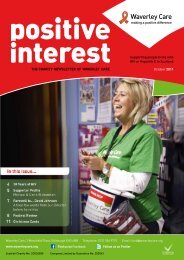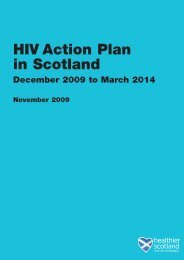I want to be like the others - Waverley Care
I want to be like the others - Waverley Care
I want to be like the others - Waverley Care
- No tags were found...
Create successful ePaper yourself
Turn your PDF publications into a flip-book with our unique Google optimized e-Paper software.
2727I <strong>want</strong> <strong>to</strong> <strong>be</strong> <strong>like</strong> <strong>the</strong> o<strong>the</strong>rsethnicity, it must <strong>be</strong> acknowledged that issues such as poverty, immigration anddiscrimination based on ‘race’ and ethnicity have a major impact on psycho-socialfac<strong>to</strong>rs and o<strong>the</strong>r health-related quality of life issues and, <strong>to</strong> that extent, are vital inunderstanding needs and planning services. This will also <strong>be</strong> explored fur<strong>the</strong>r in <strong>the</strong>interviews with practitioners, parents and children.3.3 Affected Children and Young PeopleRepeating Inglis and Mor<strong>to</strong>n’s (1996) methodology, <strong>the</strong> needs assessment set out <strong>to</strong>count, as accurately as possible, <strong>the</strong> num<strong>be</strong>r of children and young people currentlyliving in Scotland who are affected by parental HIV. It was known from <strong>the</strong> outset thatit would only ever <strong>be</strong> possible <strong>to</strong> come up with a rough approximation of <strong>to</strong>tal figures,<strong>be</strong>cause <strong>the</strong>re has never <strong>be</strong>en any official record kept of children affected by HIV,and <strong>be</strong>cause HIV has always <strong>be</strong>en such a secret illness, as <strong>the</strong> scoping study hasdemonstrated. It made sense, however, <strong>to</strong> re-use <strong>the</strong> approach adopted by Inglis andMor<strong>to</strong>n, firstly, so that a figure could <strong>be</strong> reached by similar means, and secondly, sothat comparisons could <strong>the</strong>n <strong>be</strong> made over time.3.3.1 MethodQuestionnaires were sent <strong>to</strong> all HIV service providers in Lothian, Greater Glasgow &Clyde and Tayside Health Board areas, asking for details of <strong>the</strong> children with whom<strong>the</strong>y had contact (see Appendices 7.1). Additionally, given <strong>the</strong> known increase in <strong>the</strong>num<strong>be</strong>r of reports of HIV infections from areas such as Fife, Lanarkshire, Grampianand Highland during 2007 (Scottish Government, 2009), <strong>the</strong> study was broadened <strong>to</strong>include <strong>the</strong>se areas. Steering Group mem<strong>be</strong>rs provided <strong>the</strong> information and contacts<strong>to</strong> agencies and practitioners working with children and young people affected by HIVin each area.The questionnaire was designed <strong>to</strong> <strong>be</strong> as simple as possible. Practitioners wereasked <strong>to</strong> identify each child/young person that <strong>the</strong>y knew <strong>to</strong> <strong>be</strong> affected by HIV orAIDS, by <strong>the</strong>ir two initials, age and sex as well as details of whom <strong>the</strong>y lived with.This ensured confidentiality and allowed key characteristics <strong>to</strong> <strong>be</strong> established,through which duplicate cases could <strong>be</strong> deleted. The questionnaire also providedinformation on <strong>the</strong> HIV status of <strong>the</strong>ir parent, sibling and any o<strong>the</strong>r family mem<strong>be</strong>rliving with HIV and <strong>the</strong> death of a parent, sibling or o<strong>the</strong>r family mem<strong>be</strong>r.A <strong>to</strong>tal of 13 agencies participated in <strong>the</strong> num<strong>be</strong>r-counting exercise:











